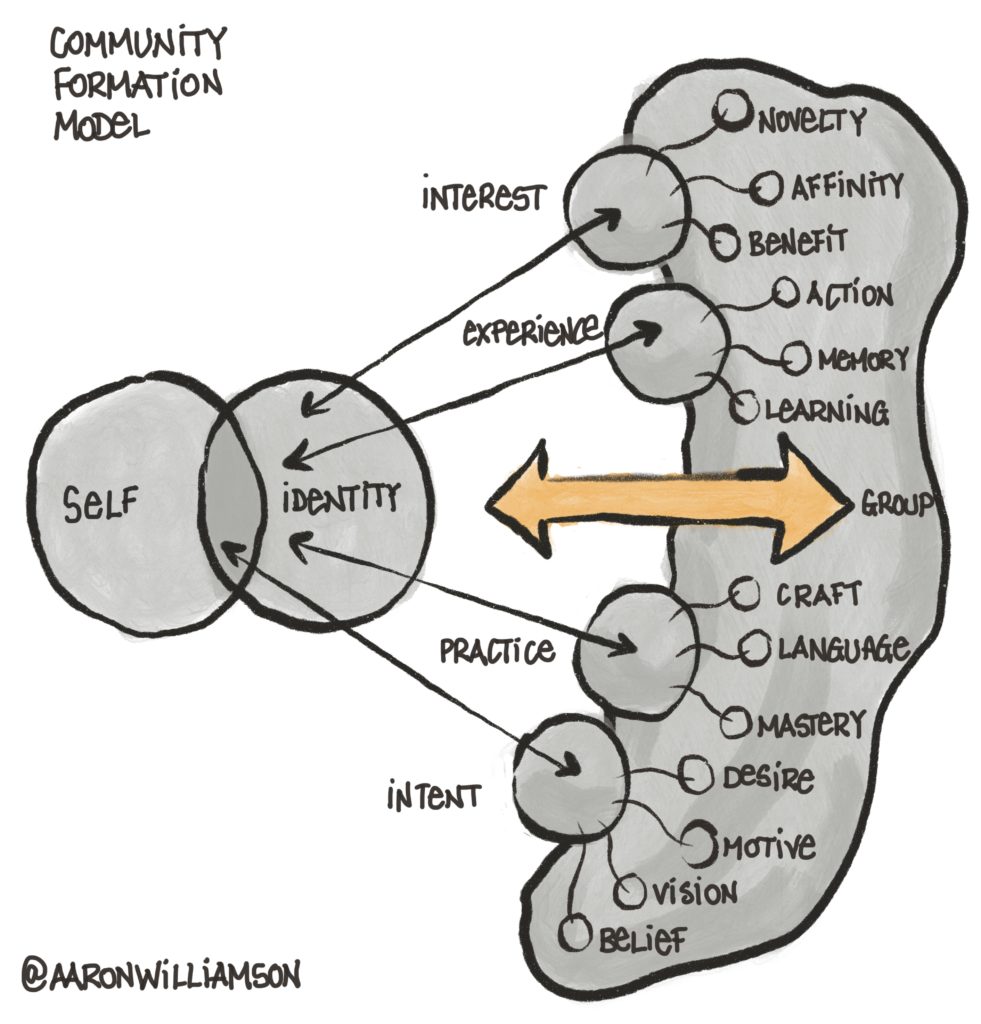
Purpose of the Model
This model was initially developed in the context of trying to answer three questions.
We were working on a project where people had come together to meet each other, and the organizers were convening people so they could have more collective impact than they could individually. Our theory was that we could more intentionally design the process of a group forming a sense of community, and that we could accelerate the the “right” people in the community discovering each other to achieve impact in a more intentional way.
The original model, then, was created to answer three principal questions:
1. What are the elements to consider in “designing community”?
2. On what basis could we match people to facilitate connection and a sense of community?
3. What sequence of interactions would allow a shared sense of community to emerge once the “right” people were together?
Assumptions in the Model
The most significant assumption in the model is the differentiation between the self, the sense of self, and the identity of the individual. This model assumes that there is a fundamental self that an individual may or may not be fully consciously aware of. It also assumes that there is a socially, culturally and contextually constructed identity that is a balance between what is projected by the individual and what is perceived by and reinforced by others. The final element is the overlap between that identity and the subconscious self, which we will call here the sense of self.
The domain of this model lies in the considerations that mediate between the external interaction points with others that cause shifts in identity and ultimately in the sense of self.
Model Description and Explanation
This model is based on principle drivers of attraction and connection that motivates individuals to interact and sustain relationships in group settings. It is a molecular model; based on the concept of molecules forming bonds of various strengths based on certain points of attraction, with the strongest structures resulting from strong attraction across multiple binding points.
The four principle binding points in the model are Interest, Experience, Practice and Intent, with an additional direct binding point around Identity itself.
Each of the binding points has sub-elements which may form the basis of the bond. Strength is measured as both the intensity of any single sub-element, but also the aggregation of multiple sub-elements within or across higher level binding points.
Put more simply, my connection potential with someone who attended the same school as me is not as strong as someone who attended the same school, was in the same club at that school, went on the same trips as I did, shares the same interests in gardening, has similar political beliefs and works in the same profession.
Interest
Attraction on interest is based on what people like or what people need. People are drawn to topics or activities based on affinity or novelty, or will connect with others based on a shared sense of need.
The more intense the identification with the interest, the more binding potential the interest can have.
Examples of communities bound by Interest include: enthusiast groups, stargazers, fan clubs, trade groups.
Experience
Experience acts as an attractor based on shared lived experience, shared memories, past shared activities and common learning. It also acts as a reinforcer of itself and and other forms of community through shared activity, which forms the basis of future shared memories and lived experiences. The more intense, novel and formative the shared experience, the more powerful this binding point becomes.
Examples of communities bound by Experience include: Alumni groups, survivor groups, support groups, user groups.
Practice
Humans possess an innate desire for competence and mastery. As particular skills require increased complexity and longer pathways to mastery, the level of self-identification with the practice and the desire to connect with others increases both for social learning and recognition.
Examples of communities bound by Practice include: professional guilds, martial arts, crafting communities, professional associations
Intent
Communities of intent form around shared beliefs, ideals or causes – they tend to be activity, action or outcome oriented. These can be highly energetic communities, and that energy can also make them volatile and subject to fracture.
Examples of communities bound by Intent include: religious groups, social movements, activist groups
Identity
While all of the above community types interface with, are informed by and help shape Identity, Identity can, itself, act as the basis of community, often based on immutable characteristics that are perceived to create in-group/out-group differences. Any of the above community types can become a strong element of self-identity, however, which represents the most robust and resilient form of any community type.
Examples of communities based on Identity include: cultural diasporas, LGBTQ2S+ groups, crypto HODLers
I will be outlining different methods for how to use this model in a separate post.
It’s a great deconstruction of community!